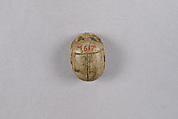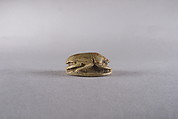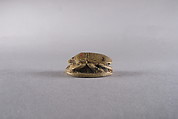Scarab with Representations of Hapi
Third Intermediate Period or Late Period
The underside of the scarab shows the Nile god Hapy, identified by his headdress of papyrus stalks. He is the personification of the annual inundation and therefore also one of the ancient Egyptian fertility gods. Even though Hapy is generally portrayed holding the sema-tawy as symbol of two tied plants that indicate the unification of Egypt, he is shown here on either side of a large papyrus. The similarity in gesture and general composition indicates that here, too, reference is made to a unified Egypt. On Egyptian seal-amulets, such compositions are known from the Ramesside Period (ca. 1295–1070 B.C.) onwards. In the period in which this particular scarab was made (probably Dynasty 25–26, ca. 733–525 B.C.), two Nile gods on either side of a papyrus are also frequently attested on scarabs from the Phoenician world, inspired by Egyptian models.
This image cannot be enlarged, viewed at full screen, or downloaded.
This artwork is meant to be viewed from right to left. Scroll left to view more.





